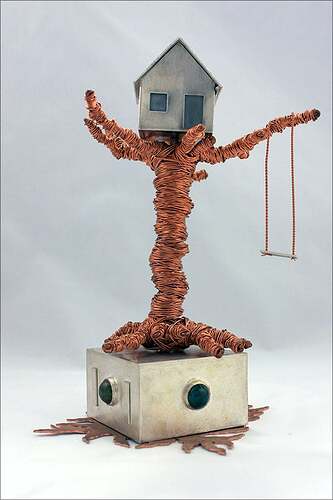Materials: sterling silver, copper, moss agate
Dimensions: 90 x 90 x 153 mm
The reliquary for childhood is a tree with a treehouse and a swing. The treehouse is a container that is opened by tipping the hinged roof.
Photo credit: Sarah Groves
Sarah Groves
Blue Box Design
Vancouver, BC. Canada
Reliquaries for Relicts of the 20th Century
Inspired by bejewelled reliquaries in precious metals from the Christian church of the late Middle Ages, I designed designed and made three reliquaries for conceptual relicts of the 20th century - biodiversity, childhood and peace.
Biodiversity of the planet diminished at an unprecedented rate during the 20th century, and the losses are irreversible. The reliquary for biodiversity represents these losses.
Childhood was once characterized by timeless days of unstructured and independent play. During the 20th century, children began to lead highly structured and supervised lives. The reliquary for childhood represents these vanishing qualities of childrens’ lives.
Peace was rare during the 20th century. Global peace existed for only a few weeks in September 1945 when there were no declared wars anywhere on the planet. The reliquary for peace represents the fleeting nature of peace.
These containers and vessels definitely hold their place in the world of stunning art objects as well as in the world of metalsmithing.
Since the dawn of time humans have created containers to hold things that were important to them, from large vessels to hold food and harvests to intimate containers for small precious things. They might hold memories, ashes, medicine, beverage, fruit or food - but all spring from the imagination and skill of the maker. Some have specific religious functions, some are meant for everyday use. When one thinks of a vessel or container the inclination is to think of something with solid walls - yet many of these works involve the exploration of positive and negative space, and the use of negative space to help create the illusion of the wall of the vessel.
As the world’s largest jewelry related internet site, Ganoksin strives to develop exhibitions showcasing work from around the world. This exhibition was open to all metalsmiths, professional and amateur, advanced and beginner. Participants are from The Netherlands, the USA, Canada, Australia, Costa Rica, the United Kingdom, Israel, Hong Kong, Colombia, Romania, Italy, Ireland, Japan, Malaysia and Denmark. While most of the pieces are by an individual metalsmith, some are collaborations, one of three artists spanning 50 years.
In total 319 artists contributed 729 show pieces for the permanent online exhibition.
Objects in the exhibition include boxes, lockets, urns, ash containers, bowls, wine cups, reliquaries, match holders, vases, teapots, pitchers, sugar bowls, baskets, nests, pillboxes, clutches and a range of sculptural forms. A variety of techniques are showcased covering a wide range of metalsmithing techniques. Materials used include everything from gold and silver to less expensive metals. Ornamentation includes the addition of enamel, chasing and repousse’, gemstones and found objects.
The exhibition was curated by Beth Wicker, President of the North Carolina Society of Goldsmiths in the United States, and Adjunct Instructor at Northeastern Technical College in South Carolina. Director of the exhibition is Hanuman Aspler, founder of The Ganoksin Project, the world’s largest internet jewelry site.
